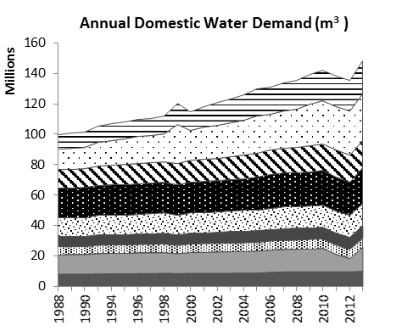Impact of Rapid Tourism Growth on Water Scarcity in Bali, Indonesia
DOI:
https://doi.org/10.51264/inajl.v2i1.14Keywords:
Badung Regency, clean water demand, water scarcityAbstract
Despite Bali’s dependency on tourism, concerns over the impact of tourism on water scarcity are increasing. The objective of this study is to analyze the clean water demand related to tourism growth and compare them with the available clean water supply. This study suggested that tourism water demand has increased by 20.8 million m3 (295%) from 1988 to 2013. Sixty-eight percent of the increase was concentrated in Badung Regency, where the tourism water demand ratio has increased from 31% to 46%. The study also suggested that rapid population growth has caused an increase in domestic water demand by 48.3 million m3 (48%). This study also shows that the capacity of clean water supply in Bali has increased significantly to meet these demands and the water supply coverage of domestic water demand has increased significantly from 13% in 1988 to 53% in 2013. The water supply coverage of tourism demand varies from year to year with an average of 28% in the study period. The increasing issues over water scarcity despite the improvement in the coverage of domestic water demand suggest further investigations. Yet, despite the large gap between supply and demand in the tourism sector the industry still can have undisrupted clean water throughout the year. This indicates the use of alternative clean water which can be obtained locally such as groundwater. Wise water management through the sharing of scientific data, including in the tourism sector is imperative in solving water scarcity in Bali.
Keywords: clean water demand, water scarcity, Badung Regency
References
Becken S. 2014. Water equity – Contrasting tourism water use with that of the local community. Water Resources and Industry, 7-8, 9-22. doi: 10.1016/j.wri.2014.09.002
BPS Provinsi Bali (Statistics of Bali Province). 1983. Bali Province in Figures. Bali.
BPS Provinsi Bali (Statistics of Bali Province). 2000. Bali Province in Figures. Bali.
BPS Provinsi Bali (Statistics of Bali Province). 2014. Statistik Air Bersih Provinsi Bali 2014. Bali.
BPS Provinsi Bali (Statistics of Bali Province). 2016. Bali Province in Figures. Bali.
Cole S. 2012. A political ecology of water equity and tourism. Annals of Tourism Research, 39(2), 1221-1241. doi: 10.1016/j.annals.2012.01.003
Gössling S, Hall CM and Scott D. 2015. Tourism and Water. Bristol: Channel View Publications.
Gössling S, Peeters P, Hall CM, Ceron JP, Dubois G, Lehmann LV and Scott D. 2012. Tourism and water use: Supply, demand, and security. An international review. Tourism Management, 33(1), 1-15. doi: 10.1016/j.tourman.2011.03.015
Gössling S. 2001. The consequences of tourism for sustainable water use on a tropical island: Zanzibar, Tanzania. Journal of Environmental Management, 61(2), 179-191. doi: 10.1006/jema.2000.0403
Grey D and Sadoff CW. 2007. Sink or Swim? Water security for growth and development. Water Policy, 9(6), 545. doi: 10.2166/wp.2007.021
JICA, Yachiyo Engineering Co. Ltd. and Nippon Koei Co. Ltd. 2006. The comprehensive study on water resources development and management in Bali Province in the Republic of Indonesia final report: main report. Bali
Leng RA, Stambolie JH and Bell R. 1995. Duckweed - a potential high-protein feed resource for domestic animals and fish. Livestock Research for Rural Development, 7(1), 7. http://www.cipav.org. co/lrrd/lrrd7/1/3.htm.
Lukman, Ridwansyah I, Nomosatryo S, Badjoeri M, Nasution SH and Dina R. 2012. Pertimbangan dalam pengembangan budidaya ikan pada karamba jaring apung di Danau Toba. Prosiding Seminar Nasional Limnologi V, Bogor, 65-78.
Muhajir A. 2015, 22 April 2015. Pariwisata lahirkan ancaman krisis air di Bali. Retrieved from http://www.rappler.com/world/regions/asia-pacific/indonesia/90735-pariwisata-ancam-krisis-air-bali
Mulyadi A. 2011, 4 May 2015. Bali Krisis Air Bersih, Online Article, Kompas.com. Retrieved from http://nasional.kompas.com/read/2011/05/04/19321775/2015.Bali.Krisis.Air.Bersih
Osman KM, Mohamed LA, Abdel Rahman EH and Soliman WS. 2009. Trials for vaccination of tilapia fish against aeromonas and pseudomonas infections using monovalent, bivalent and polyvalent vaccines. World Journal of Fish and Marine Sciences, 1(4), 297-304.
PDAM Tirta Mangutama Kabupaten Badung. 2017, 24 February 2017. Tanggapan, Keluhan, Kritik & Saran Dari Pelanggan. Retrieved from http://www.pdam-badung-bali.co.id/tanggapan-pelanggan-s-32.html
Shakeela A. 2015. Water Crisis Management in a Tourism Dependent Community International Journal of Social, Behavioral, Educational, Economic, Business and Industrial Engineering, 9(12), 4082-4086.
Sulastri and Nomosatrio S. 2005. Perubahan komposisi dan kelimpahan fitoplankton Situ Cibuntu, Cibinong, Jawa Barat. Limnotek Perairan Darat Tropis di Indonesia,12 (2), 92 – 101.
Suriyani LD. 2015, 15 April 2015. Bali terancam krisis air, mengapa? Retrieved from http://www.mongabay.co.id/2015/04/15/bali-terancam-krisis-air-mengapa/
Tapper R, Hadjikakou M, Noble R and Jenkinson J. 2011. The impact of the tourism industry on freshwater resources in countries in the Caribbean, Mediterranean, North Africa and other regions. London.
Tarigan H., Dharmawan AH, Tjondronegoro SMP and Suradisastra K. 2014. Conflict of water resources and marginalization subak: case studies in Tabanan Bali. International Journal of Research In Social Sciences, 4(4), 96-106.
Tirtomihardjo H and Setiawan T. 2011. Simulasi Aliran Air Tanah: Cekungan Air Tanah Denpasar-Tabanan, Provinsi Bali. [imulation of Groundwater Flow: Denpasar-Tabanan Groundwater Basin, Bali Province]. Jurnal Geologi Indonesia (Indonesian Journal on Geoscience), 6(3), 145-163. doi: 10.17014/ijog.v6i3.123
Trisnawati H. 2012. Dampak perkembangan infrastruktur pariwisata terhadap konflik air di Kabupaten Badung dan Tabanan. Jurnal Ilmiah Pariwisata, 2(1), 109-222.
Widiadana RA. 2012, 5 September 2012. Tourism Industry Responsible for Water Crisis in Bali, The Jakarta Post. Retrieved from http://www.thejakartapost.com/news/2012/09/05/tourism-industry-responsible-water-crisis-bali-expert.html
Widyaswara IWE. 2015. Krisis air di Denpasar makin jadi, Made Nyemplong beli 8 galon per hari.
Wiranatha AS. 2001. A systems model for regional planning towards sustainable development in Bali, Indonesia. Doctor of Philosophy Case-study Dissertation, The University of Queensland, Queensland.
World Travel and Tourism Council. 2016a. Economic Impact 2016: Annual Update Summary. London.
World Travel and Tourism Council. 2016b. League Table Summary 2016. London.







